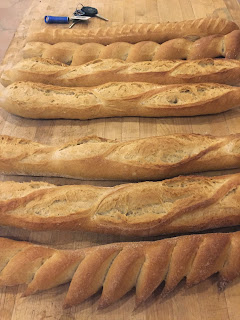
Focaccia #3:
20% levain, 7% EVO, 400g portions. Baked at 400f 28 min.
The taste is nice, the best by far being carrot and dill, which I want to keep as a signature. I've found that many of the herbs and greens I put on the focaccia blacken and lose all flavor in the oven, so I want to avoid garnishes that are susceptible to that. Delicate herbs can be worked into the dough itself. Also, it hit me the other day that you can also garnish the loaves after they are baked, especially if you want to use garnishes that cannot stand up to any heat like flours.
Whole Wheat #2:
Fruit and nuts added- raisins, apricots, pears, hazelnuts and pecans. 4% sugar, 3% fat to slightly tenderize. 20% levain, 15% whole wheat flour and 15% rye flour.
The loaf was decent - I put it in a loaf pan which I like for this variety, even if it's a totally lean dough. However the garnishes should be at least doubled, as they were pretty sparse throughout the dough. The taste of the bread itself was nice.

Baguette #6:
Poolish again, this time roughly 3 to 2 poolish to levain, with just 2g of yeast to boost the dough.
Came out nicely, with wonderful scores and color and a great crumb. If I can, I would like to explore the pate fermente loaves better because since I am using some levain in the dough, the pate fermente would have levain and commercial yeast in it. It is also slightly more convenient.




















































